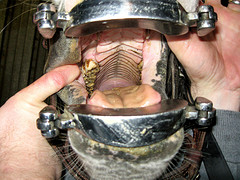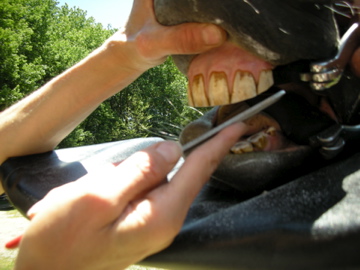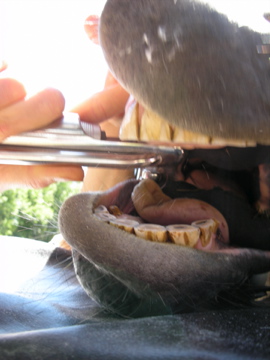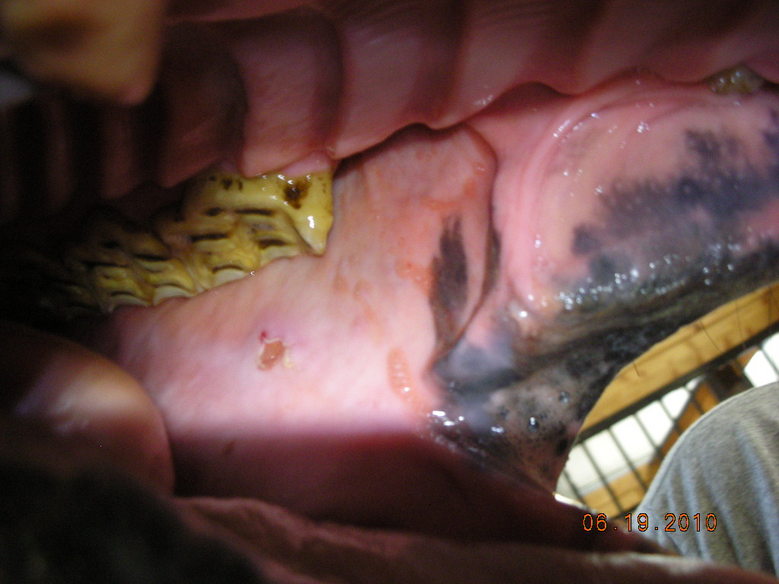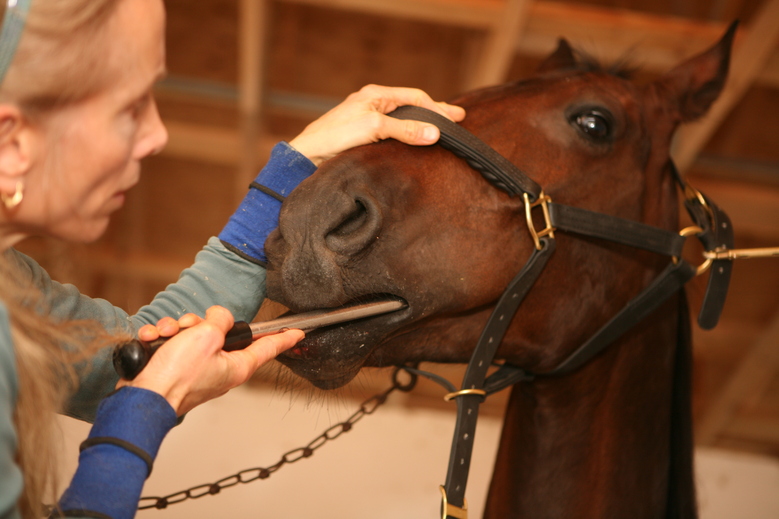

Equine Dental Care & Therapy
"Delivering excellent results to the Horse Racing Industry"
"Hire the Best ~ Beware of the Rest"
"Delivering excellent results to the Horse Racing Industry"
"Hire the Best ~ Beware of the Rest"
This site is Owned & Designed by
D.K.Dental & KnL Designs
copyright ©2009-10
D.K.Dental & KnL Designs
copyright ©2009-10
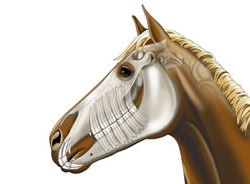
What is Teeth Floating? and Is It Necessary?
Every horse’s teeth will continue to erupt throughout the course of his life
This results in the natural and complementary diminishment of their front teeth
along with their back teeth, the molars and the pre-molars.
When horses are stabled and receive “feed” which is less dense than their natural wild diet of grass,
they do not ever make use of their incisors while their back teeth alone work to grind the soft,
less dense “feed" we provide them.
The result is that the horse develops overly long incisors and a variety of variations
of compensation for these lengthy teeth.
While, wild horses will certainly have sharp points and other possible abnormalities,
human beings are not asking them to perform with bridles
and saddles and heavy weight on their spines, nor to break record times or win races.
To ask a horse to perform under saddle, to wear equipment, and heed our demands,
requires us to understand and prevent pain, and infliction of wounds to the mouth and the overall horse.
This is why it is essential that we understand that the entire mouth of the horse must be examined
and back teeth and incisors not be overlooked, as is happening so often when someone arrives to
“float your horses teeth.”
What is commonly seen is a horse’s teeth which are only "floated"
on the occlusal surface and edges of the premolars,
the first molar of the lower jaw, and the premolars and edges of the upper jaw.
Now your horses teeth are “shorter” in some of his back teeth but his incisors
have not equally been lowered to permit these back teeth to touch for grinding food,
by approximately 1-2 mm per year.
In their natural wild enviroment a horse will utilize all of his teeth in the cutting
and grinding process of eating grass. This dense diet grinds the teeth down naturally which
maintains the correct occlusion for the horse.
In their natural wild enviroment a horse will utilize all of his teeth in the cutting
and grinding process of eating grass. This dense diet grinds the teeth down naturally which
maintains the correct occlusion for the horse.
This results in the natural and complementary diminishment of their front teeth
along with their back teeth, the molars and the pre-molars.
When horses are stabled and receive “feed” which is less dense than their natural wild diet of grass,
they do not ever make use of their incisors while their back teeth alone work to grind the soft,
less dense “feed" we provide them.
The result is that the horse develops overly long incisors and a variety of variations
of compensation for these lengthy teeth.
While, wild horses will certainly have sharp points and other possible abnormalities,
human beings are not asking them to perform with bridles
and saddles and heavy weight on their spines, nor to break record times or win races.
To ask a horse to perform under saddle, to wear equipment, and heed our demands,
requires us to understand and prevent pain, and infliction of wounds to the mouth and the overall horse.
This is why it is essential that we understand that the entire mouth of the horse must be examined
and back teeth and incisors not be overlooked, as is happening so often when someone arrives to
“float your horses teeth.”
What is commonly seen is a horse’s teeth which are only "floated"
on the occlusal surface and edges of the premolars,
the first molar of the lower jaw, and the premolars and edges of the upper jaw.
Now your horses teeth are “shorter” in some of his back teeth but his incisors
have not equally been lowered to permit these back teeth to touch for grinding food,
and those molars farthest back, having been neglected, will be too high or "stepped".
The horse now must find a way to press his teeth harder together to grind his food.
This exerts great pressure on the front teeth, which in turn puts great pressure
on theTMJ and the POLL in the horse. Meanwhile his last molars are bearing down harder
The horse now must find a way to press his teeth harder together to grind his food.
This exerts great pressure on the front teeth, which in turn puts great pressure
on theTMJ and the POLL in the horse. Meanwhile his last molars are bearing down harder
in an effort to grind feed.
Often the horse will overjet his front teeth to slide off of the length in the rear molars so that
Often the horse will overjet his front teeth to slide off of the length in the rear molars so that
his cheek teeth will actually touch for grinding food.
This results commonly in STEPS and HOOKS
of the last molars in the mouth, and HOOKS of the first premolars behind the bars.
(Example of 206 hook below, with laceration in the cheek, red circular spot to the lower left of the point.)
This results commonly in STEPS and HOOKS
of the last molars in the mouth, and HOOKS of the first premolars behind the bars.
(Example of 206 hook below, with laceration in the cheek, red circular spot to the lower left of the point.)
SO, THE ANSWER IS "YES" FLOATING IS NECESSARY.
What Is the Procedure?
My examination is a COMPLETE AND FULL CORRECTION OF ALL TEETH,
INCLUDING INCISORS AND LAST MOLARS,
as these are typically left uncorrected and ignored by "traditional floaters."
I will provide the utmost care and precision in correcting the horse’s occlusion and performing a
FULL MOUTH FLOATING OF ALL THE HORSE’S TEETH,
using hand tools and only when necessary or required, the use of power tools.
In many of the horses I have treated, behavioral problems can be corrected
by full-mouth dentistry and my adjunct therapy when a veterinarian
has been unable to diagnose a medical condition.
First,
all horses will be fitted with a stainless steel speculum in order to hold their mouth open securely.
With a speculum it will permit an equine dental practitioner a complete view of every tooth
in your horses mouth and all oral tissue.
In general, horses are cooperative and accept the placement of a speculum in the mouth
for inspection and diagnosis; most horses do not require sedation for dental/oral diagnosis.
The dental practitioner must place a speculum in the horse's mouth to feel well beyond
the length of an index finger along cheek teeth. It is vital, for being able to float all mandibular teeth,
all hooks, steps, ramps, transverse ridges and other abnormalities of dentition.
While maxillary cheek teeth are often floated without a speculum in the horse's mouth,
it should always be used to ensure all teeth have been addressed
and to work completely all the upper and lower teeth - many teeth
are neglected by "traditional" horse floaters without training or understanding,
resulting in half-jobs that create chronic over- floating and under- floating of teeth.
Without such full-mouth procedures, an owner/trainer will assume
incorrectly that their horse has been "floated" and the horse will continue
to silently suffer until I am called to examine the horse completely.
Depending upon the work your horse needs, and depending upon his/her disposition,
sedation may or may not be necessary.
I ask that you understand, that for the horse's safety,
and ours, it may be necessary to sedate a horse in order
to complete the job to the highest standard.
Veterinary sedation has never required any "reversal" in any instance of my practice.
Your horse will be standing when sedated and is usually fully alert and able to eat
one to two hours after the dental work is completed.
Your veterinarian should be available for sedation, and may consult with me
to adjust dosage accordingly.
I will examine the body of the horse before and after dental work and test your horse
for other physiological symptoms.
I will perform POLL and NECK MASSAGE along with STRETCHING
FOLLOWING THE EQUINE DENTAL PROCEDURES.
*******Special Note******
Clients are asked to observe the examination and the procedures
in order to better understand their horse’s dental/oral condition and what is required
to accomplish a true and complete correction of the horse’s mouth from front to back.
I also work with all my clients to instruct them in particular techniques,
of massage to apply to their horse, so that they can learn to
understand and aide their horse independently.
So if your vet, equine dentist or tech is only
"floating cheek teeth"
without correction of hooks, steps and incisors,
your horses mouth will end up going another year without ever having had
his problems corrected.
Lacerations, hooks, steps, waves and lengthy incisors
become silent chronic problems with each passing year.
POWER TOOL FLOATING CAUTION: You may see videos in other sites of people
completely flattening the occlusal surfaces of horse molars - BEWARE. These methods
are the work of those who have no understanding of DENTAL ANATOMY.
Grinding off the occlusal anatomy of horse teeth is NOT MY PRACTICE.
AND AGAIN!
BEWARE OF ONLY “CHEEK TEETH FLOATING”.
HAVE YOUR HORSE’S MOUTH EXAMINED AND CORRECTED BY A KNOWLEGABLE
FULL MOUTH EQUINE DENTIST VET OR TECHNICIAN.
My examination is a COMPLETE AND FULL CORRECTION OF ALL TEETH,
INCLUDING INCISORS AND LAST MOLARS,
as these are typically left uncorrected and ignored by "traditional floaters."
I will provide the utmost care and precision in correcting the horse’s occlusion and performing a
FULL MOUTH FLOATING OF ALL THE HORSE’S TEETH,
using hand tools and only when necessary or required, the use of power tools.
In many of the horses I have treated, behavioral problems can be corrected
by full-mouth dentistry and my adjunct therapy when a veterinarian
has been unable to diagnose a medical condition.
First,
all horses will be fitted with a stainless steel speculum in order to hold their mouth open securely.
With a speculum it will permit an equine dental practitioner a complete view of every tooth
in your horses mouth and all oral tissue.
In general, horses are cooperative and accept the placement of a speculum in the mouth
for inspection and diagnosis; most horses do not require sedation for dental/oral diagnosis.
The dental practitioner must place a speculum in the horse's mouth to feel well beyond
the length of an index finger along cheek teeth. It is vital, for being able to float all mandibular teeth,
all hooks, steps, ramps, transverse ridges and other abnormalities of dentition.
While maxillary cheek teeth are often floated without a speculum in the horse's mouth,
it should always be used to ensure all teeth have been addressed
and to work completely all the upper and lower teeth - many teeth
are neglected by "traditional" horse floaters without training or understanding,
resulting in half-jobs that create chronic over- floating and under- floating of teeth.
Without such full-mouth procedures, an owner/trainer will assume
incorrectly that their horse has been "floated" and the horse will continue
to silently suffer until I am called to examine the horse completely.
Depending upon the work your horse needs, and depending upon his/her disposition,
sedation may or may not be necessary.
I ask that you understand, that for the horse's safety,
and ours, it may be necessary to sedate a horse in order
to complete the job to the highest standard.
Veterinary sedation has never required any "reversal" in any instance of my practice.
Your horse will be standing when sedated and is usually fully alert and able to eat
one to two hours after the dental work is completed.
Your veterinarian should be available for sedation, and may consult with me
to adjust dosage accordingly.
I will examine the body of the horse before and after dental work and test your horse
for other physiological symptoms.
I will perform POLL and NECK MASSAGE along with STRETCHING
FOLLOWING THE EQUINE DENTAL PROCEDURES.
*******Special Note******
Clients are asked to observe the examination and the procedures
in order to better understand their horse’s dental/oral condition and what is required
to accomplish a true and complete correction of the horse’s mouth from front to back.
I also work with all my clients to instruct them in particular techniques,
of massage to apply to their horse, so that they can learn to
understand and aide their horse independently.
So if your vet, equine dentist or tech is only
"floating cheek teeth"
without correction of hooks, steps and incisors,
your horses mouth will end up going another year without ever having had
his problems corrected.
Lacerations, hooks, steps, waves and lengthy incisors
become silent chronic problems with each passing year.
POWER TOOL FLOATING CAUTION: You may see videos in other sites of people
completely flattening the occlusal surfaces of horse molars - BEWARE. These methods
are the work of those who have no understanding of DENTAL ANATOMY.
Grinding off the occlusal anatomy of horse teeth is NOT MY PRACTICE.
AND AGAIN!
BEWARE OF ONLY “CHEEK TEETH FLOATING”.
HAVE YOUR HORSE’S MOUTH EXAMINED AND CORRECTED BY A KNOWLEGABLE
FULL MOUTH EQUINE DENTIST VET OR TECHNICIAN.
